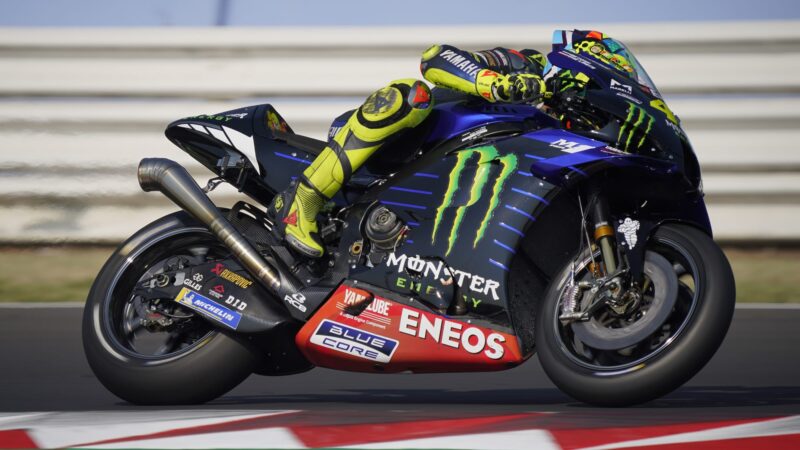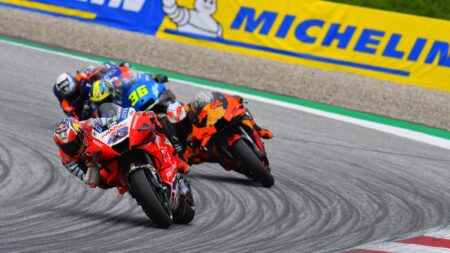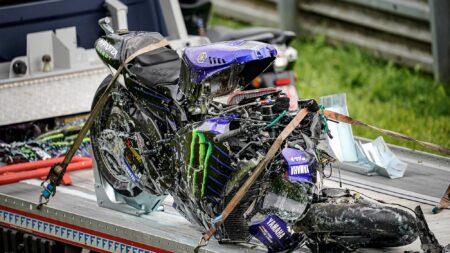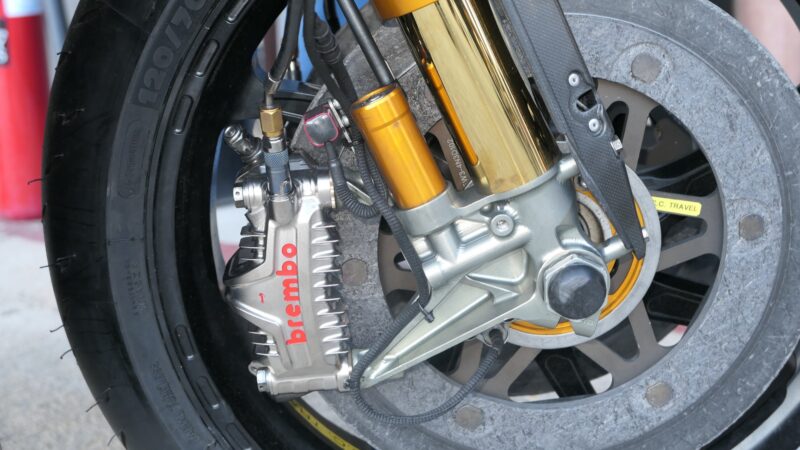Jack Miller is also keen. “I’d love to be able to chat to the boys and tell them how I’m going,” he said. “I don’t think the boys will be in your ear the whole race. I think they’ll only be on the radio if they’ve got some suggestions. As soon as they start telling you, ‘Hey try and fix up Turn Two’, or something I’d just tell them to shut up!”
Some riders and most fans are horrified by the thought of pit-to-rider radio that would increase the role of engineers during races – advising riders about the performance of their motorcycle and the about the performance of other bikes and riders.
“If Race Direction can tell us the more important safety things, without the messages distracting us, then that’s very good,” said Pol Espargaró. “But the problem will be the next step, which will be engineers trying to control what you’re doing on the bike. They’re going to tell you about tyre wear, they’re going to tell you what to do, so in the end the racing will be less human and more machine. This is what’s happening in F1 and I don’t like it. I want to keep MotoGP a more human sport.”
Ducati sporting director Paolo Ciabatta agrees. “On one side whatever helps riders to know about dangerous things is good,” he said. “But on the more romantic side, my personal opinion is that the good thing about motorcycle is that the rider is out there by himself, doing the best he can with what he has.
“Maybe the engineers would like to be able to communicate with the riders but already they can give map info via the dash and pit signals, so I say let the riders do the job, using their talent, their feelings and their experience. For the show it’s probably better to leave it as it is.”
Many people in Formula 1, including Motor Sport journalist Mark Hughes, hate what radio comms have done to the F1.
“Formula 1 went this way and it contributed hugely to the philosophical taming of the drivers,” said Hughes, one of the most respected voices in the F1 paddock. “It’s made them much more publicly employees rather than stars; which is not the image it should be projecting to the outside, regardless of the realities.
“The sport has recognised this with radio restrictions regarding driver coaching, but in the meantime, the radio has enabled vastly more complex control systems that require guidance on how to use – hence the current controversy about whether teams should be allowed to tell a driver that his gearbox or brakes need nursing or the engine is in incorrect mode and so on.
“I personally feel it should be pit boards only, once they leave the pit lane, and the control systems should be simplified accordingly. I’d hate to see MotoGP follow F1’s misguided engineering-led path on this.”
During Tuesday’s Misano tests Dorna had several riders evaluate the technology. Their main focus was evaluating the effectiveness of Race Direction radio messages – can riders hear the messages and might they be distracted by them at critical moments? There will further tests later in the year, with the focus on improving the receivers, noise-cancelling headphones and so on.
Quartararo to get big title boost at Barcelona
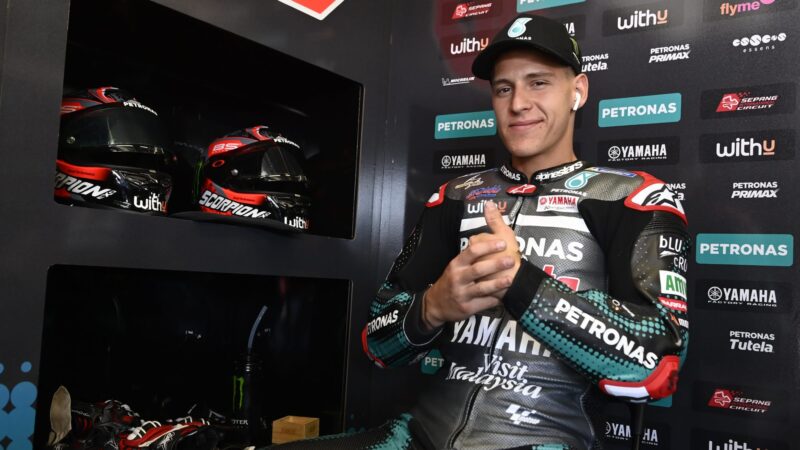
After four disastrous races Quartararo needs some good news
Petronas SRT
What does Fabio Quartararo want for Christmas? We don’t know, but he will be like a kid on Christmas day when he arrives in Barcelona next week.
All being well Quartararo will find two Yamaha crates with his name on them. Inside the crates will be his two YZR-M1 engines that were taken out of circulation – just to be sure – when Yamaha ran into reliability problems during July’s Spanish GP. Both engines, along with three broken engines belonging to Valentino Rossi, Maverick Viñales and Franco Morbidelli, were flown to Yamaha’s race department in Iwata, Japan, for inspection. Only now are Quartararo’s being returned to Europe.
Since the end of the first Jerez race the French title hope has been restricted to just two engines, with Yamaha keeping his fifth and last engine in reserve. Obviously this puts him in a hugely vulnerable position, so it’s a massive boost to his title hopes to have five engines for the final eight races.
“We are crossing our fingers to have some great news for Barcelona – Yamaha are working hard,” said Quartararo at Misano.
In fact when the engines do arrive Quartararo will be the only Yamaha rider with five at his disposal, because those belonging to Rossi, Viñales and Morbidelli are dead.
Yamaha admits to valve problems, apparently due to a faulty batch from an outside supplier. Factory engineers were able to dismantle the three broken engines to find the fault, but Quartararo’s suspect engines could not be unsealed, if they were to remain in his allocation, so Yamaha may have used endoscope cameras to look inside.
It’s not known if Quartararo’s returned engines will need to run at reduced revs, but the megaphone exhaust used by Rossi during Tuesday’s tests suggests that Yamaha engineers are working to get a better spread of power from the M1 engine, which implies they have less peak rpm to work with.
Yamaha’s engine allocation
Black cross denotes engine use by event and session. Red denotes engine broken and withdrawn
Fabio Quartararo

Franco Morbidelli

Valentino Rossi

Maverick Viñales

How KTM went from Czech/Styrian wins to nowhere at Misano
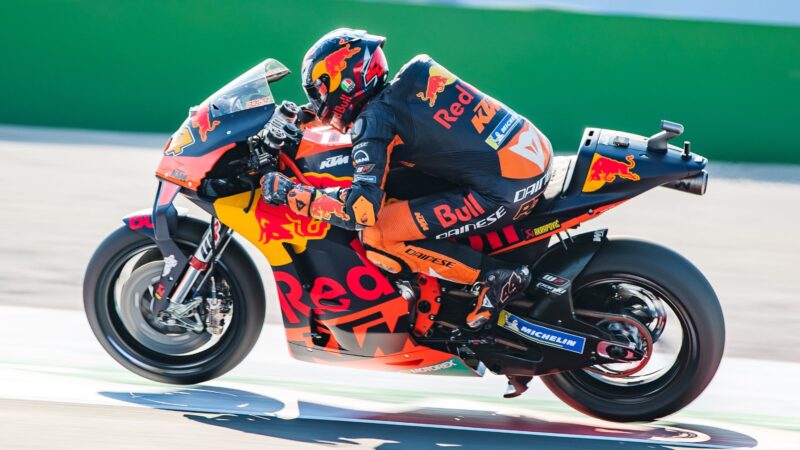
Michelin’s 2020 rear slick is usually a big help to KTM, but it wasn’t at Misano on Sunday
Red Bull
Misano was a bit of a shocker for KTM, which had been fully competitive at Jerez, Brno and Red Bull Ring. By the time MotoGP left Austria many pit-lane people were convinced that the factory’s 2020 RC16 was the best bike on the grid, but at Misano KTM’s riders struggled to bother the top ten.
KTM’s speed at the first tracks was hugely impressive, especially since the RC16 is the only V4 MotoGP bike that seems to have fully unlocked the secret of Michelin’s 2020 rear slick.
While Ducati’s championship leader Andrea Dovizioso and Honda’s world champion Marc Márquez have complained about the tyre, Pol Espargaró believes it has helped KTM get to the front.
“This tyre brings us more stability and more consistency,” said the Spaniard at Misano. “Maybe this consistency is also something that helps Yamaha. I think Ducati are the most damaged by this tyre, but I cannot give you a technical answer why.
“The most important thing we were losing last year was consistency and this year we have it, so we can keep the same pace we do in practice. It is super-helpful and we like it.”
The new tyre – with slightly softer construction for more deflection for a larger contact patch and more grip – is a huge help to Espargaró on corner exit.
“The problem in previous years was that the tyre was already spinning a little before my first touch of the throttle, so I started generating spin and when I lifted up the bike to go straight the spin increased and I lost time,” he added.
